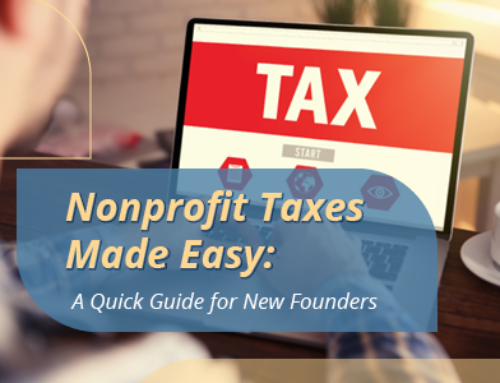![]()
Part of becoming a fully funded nonprofit is learning to analyze your fundraising metrics.
In short, it’s about knowing your numbers.
But not just any numbers – the important ones.
You see, the right numbers will tell you how you’re doing. They’ll show you if you’re on target to reach your goals.
Or not.
Because fundraising is not just about asking, asking, and asking some more.
You have to be focused on more than just income.
You need to understand what works and what doesn’t.
If you find yourself behind, then reviewing your fundraising metrics might give you a clue as to why.
You see, numbers don’t lie. Your fundraising metrics take the guesswork out of managing your efforts and show you how you’re doing.
The big question, especially if you’re not a numbers person, is what should you be measuring and why?
Let’s start with the “why” of numbers management in your nonprofit.
Why You Need to Monitor Your Fundraising Metrics
Did you know that numbers can teach you something?
They absolutely can!
Your fundraising metrics will show you if you’re spending your time on the right strategies.
For example, before sending out an annual appeal, consult your metrics from previous years and see what the numbers say.
- Did you get a better rate of return when you sent your letter in October instead of December?
- How about when you send a letter with photos compared to a letter without?
- What about when you included a reply card or a return envelope? Did that yield better results?
 When you plan your current fundraising appeal or campaign based on lessons learned from previous efforts, you’ll get better results, every time.
When you plan your current fundraising appeal or campaign based on lessons learned from previous efforts, you’ll get better results, every time.
Yet many people ignore their fundraising metrics, preferring to dive into the work without any data to drive their decisions.
Or they make decisions based on emotion instead of data, which is not a good idea.
You don’t have to be a hard-core numbers person to get started reviewing your data and using your findings. And don’t buy into the mindset that you’re bad at math and therefore should stay away from numbers. Bad move!
Spend a little time to get comfortable with your numbers and you’ll be amazed at what you can learn.
When I first started in fundraising, I was definitely not a numbers person! I didn’t understand any of the financial reports and the budget gave me hives.
But I quickly learned that I needed to understand a few things. So I made a commitment to myself that I would try to learn just one thing from every opportunity, like a Finance Committee Meeting or a workshop.
And you know what? Over the course of a year or two, I learned a LOT! I’m still no numbers genius, but I know how to look at a set of fundraising data and see where you’re doing things right and where you need to work a little harder.
I challenge you to do the same. Build your knowledge a little piece at a time and soon you’ll have a firm grip on what you need to know.
Ok, now let’s look at WHAT you should be monitoring in your fundraising metrics.
Fundraising Metrics Worthy of Your Attention
Over the years, I’ve found that there are a handful of numbers that every nonprofit should be reviewing on a regular basis and understand what the numbers mean.
Having this information at your fingertips will make fundraising planning a lot easier!
 1. Gap: This number provides context for the need you’re working to meet and tells people why they should give. It’s pretty basic: you find out what the total need is that your nonprofit is addressing and subtract the amount of services you’re currently providing. The result is the gap or the work left to be done.
1. Gap: This number provides context for the need you’re working to meet and tells people why they should give. It’s pretty basic: you find out what the total need is that your nonprofit is addressing and subtract the amount of services you’re currently providing. The result is the gap or the work left to be done.
Total need – current service delivery = gap
You instantly create a sense of urgency when you explain the gap and how desperately people need what you provide.
In your appeals, give the donor the opportunity to close the gap, to provide needed services to a person or an animal. People love it because they’re clear about how they’re making a difference.
Let’s look at an example. Let’s say you currently have 50 at-risk students enrolled in your college prep program. You estimate there are about 500 total in your community that could really benefit from your program, giving them the chance to get a college education and maybe become the first person in their family to get a degree.
Do the math: 500 teens in need minus 50 you currently serve = 450 who need service.
That gap tells donors the size of the remaining problem to be solved. If your goal is to cut that gap in half in the coming year, the donor can see how their support will help.
For some nonprofits, the overall need might be huge – hundreds of thousands of people or animals. Your organization may never have the capacity to completely meet that need, but could you serve 10% more? 20% more?
Deciding on that increase is part of your strategic planning and needs to be carefully considered. Sometimes an increase that’s more than about 10% means you need to grow your capacity to serve, meaning you may need to hire more staff or get a bigger facility.
You might need a bigger fundraising goal than you thought to accommodate that increase in your goal. It’s totally fine to do that, just be ready to increase your infrastructure and fundraising to accommodate the growth in your programs.
Look at your own numbers and think about the gap you need to fill. Calculate how much it would cost to fully fund your mission if you decided to close that gap.
I know, that could be huge!
Don’t be afraid to think big and to dream big. It may be time for your nonprofit to take a big step toward living its mission to the fullest.
2. Core Number: This number shows how much it costs to deliver one unit of service. This one number makes fundraising so much easier because people can quickly and easily understand how their donation will make a difference.
Start by defining your unit of service. For a homeless shelter, it may be one night’s stay, along with a meal and shower. For a food bank, it might be 1.5 pounds of food, which equals one meal.
Asking for money is so much easier when you can use your Core Number in your ask. In short, you’re not asking for $10 to support your nonprofit’s operating budget, you are asking for $6.20 to provide one day and night of food, shelter, and veterinary care for a homeless animal.
The easiest way to calculate your Core Number is to pick a year, either last fiscal year or calendar year, and use those numbers. Find the total expenses for that year and the total units of service delivered in that same year.
Then simply divide your total expenses by the total units of service you delivered.
For example, if you spent $150,000, and you provided 1,500 animals with an average stay of 40 days, your core number would look like this:
Unit of service: 1 day/night of care for 1 animal
Total units of service last year: 1,500 animals X 40 days/nights = 60,000 total days/nights
Total expenses: $150,000
Your Core Number is $150,000/60,000 = $2.52
Now you can tell a prospective donor that for just $2.52 they can ensure that a homeless dog has shelter and care while they wait to be adopted.
And for just $25.20, they can provide for 10 dogs, or for one dog for a 10-day stay.
What a great value!
If you don’t want to do the math yourself, use our handy Core Number Calculator tool to crunch the numbers for you.
Once you understand your Core Number, you can talk to your donors using words and numbers that will resonate and inspire them to give.
 3. ROI per fundraising activity: ROI stands for return on investment and it’s something you need to know about every fundraising activity you do. If you don’t know the ROI, you don’t know if an event or campaign was worth the time and energy that went into it.
3. ROI per fundraising activity: ROI stands for return on investment and it’s something you need to know about every fundraising activity you do. If you don’t know the ROI, you don’t know if an event or campaign was worth the time and energy that went into it.
The truth is, you probably know deep in your soul when an event wasn’t worth it. You feel exhausted and discouraged by the amount of money you actually raised. But if you evaluate events based on how you feel the next day, you are going on emotion, not numbers. That’s not a smart way to manage your organization!
Instead, calculate the ROI for that event so you know if it was profitable or not.
Simply put, return on investment is simply a way of expressing your revenue compared to your expense.
ROI = Profit – Expenses/Expenses
For example, let’s say you hold a fundraising event that brings in $50,000 in revenue. You spent $10,000 on catering, decorations, and staff time spent organizing the event.
Profit = $50,000 – $10,000 = $40,000
ROI = profit of $40,000/expenses of $10,000 = 4
That means that for every dollar you spent, you made four dollars.
Congratulations, that’s a solid ROI!
Most nonprofits don’t even try to calculate ROI on fundraising events. They decide to do the event next year based on whether their guests had a good time. Often, nonprofit leaders are satisfied if their event at least made some money. “We made some new friends, so that’s good!”
And making friends is good!
But if your event has a terrible ROI and you are only bringing in 50 cents on every dollar spent … think about what you could do instead that would have a better ROI and bring in more money for your nonprofit.
A common pitfall for organizations when they calculate ROI is neglecting to include staff time. When paid employees spend significant time organizing an event, that’s time that could be spent on other tasks that could yield more money.
Do yourself a favor and commit to examining the true costs of every fundraising event and campaign.
That will give you the data you need to decide whether or not a fundraising activity should go on this year’s calendar or not.
4. Exact Revenue Goal: While it seems obvious that a nonprofit leader must know their exact revenue goal for the fiscal year, many people keep themselves in the dark. They figure they will raise as much money as they can and spend it as they go. This is backwards and will keep you stuck!
Instead, do fundraising RIGHT by first setting a goal that’s based on what your program goals are for the year.
In short, start by determining your annual budget for the upcoming fiscal year. List every anticipated expense. If you are in your first year of operation and this is your first operating budget, you will have to think ahead about every expense your organization will encounter, from postage to mail the annual appeal to the annual cost of your social media scheduling tool.
The task gets much easier when you can use your previous year’s budget as a starting point.
After you determine how much money you need to run your programs for the coming year, the next step is to plan how to bring in the revenue you need to fully fund that budget. By the way, best practice is to get this work done about three to six months prior to the start of the fiscal year.
The expression if you fail to plan you are planning to fail really applies here!
If all you can say when people ask how much money you need to raise is “a lot,” or “more than last year,” you aren’t going to raise the kind of money you need because people have no idea how much to give.
When you start with expenses and then build your revenue, you will be able to see if the numbers are going to align or not. What if you realistically can’t raise enough revenue to cover your expenses for the coming year? Then you can make cuts now, six months ahead of time, rather than in real time when the money isn’t coming in.
5. Donor retention rate: This one is key for the long-term success of your organization. How many donors are continuing to donate year after year? The more donors you inspire to keep giving, the more fiscally solid your organization becomes.
And if you aren’t paying attention to this number, it’s a problem, because it means you’re more focused on the money than on your donors. Big mistake!
The people who give to your organization every year feel connected to the work and are bought-in. They’re showing you that with their behavior.
Repeat donors are loyal donors and will support you year in and year out, even in bad times. When a donor loses interest in your work and stops giving, that is one less donor you have and one more donor you need to go out and get.
If you’re using a good donor tracking software, it will track your retention rate for you which is good news. Crunching donor retention rates manually is tricky and I try to avoid it if I can.
Across the board, donor retention is 47%. This means that if you start the year with 100 donors, you will end the year with 47. You lost 54 donors and must replace them next year just to keep your funding the same. Finding new donors is harder and costs more than renewing the donors you already have.
So, if you’re not paying attention to donor retention, it’s time to start. And the starting place is knowing your donor retention rate.
Then you can decide what you need to do to give donors a reason to keep giving.
 6. Donor base size. How many donors do you need to fund your organization’s important work? Only when you know how many donors you need can you choose the right strategies to find new donors.
6. Donor base size. How many donors do you need to fund your organization’s important work? Only when you know how many donors you need can you choose the right strategies to find new donors.
Yes, you need as many donors as possible. The more you have, the more money you can raise. But “as many as possible” isn’t a number you can work with.
So, here’s how to figure out the size of a donor base you need:
Let’s say you need $100,000 to fully fund your nonprofit’s work for the year, and you have these fundraising strategies planned:
- Grants: $25,000
- Fundraising event: $25,000
This means you have to bring in $50,000 from individual donors.
If you know your donors have given an average of $50 in the past, then you can calculate the number of donors you need:
$50,000 (amount needed)/$50 (average gift) = 1,000 donors
If you do a good job of stewarding new donors and helping them feel good about giving to your organization, they may give twice during the year, which means you will need fewer donors.
A robust monthly giving program will also reduce the number of total donors you need.
Knowing how many donors you need will give you a goal to aim for.
Working the fundraising math this way helps you decide where to focus during the year so you’re using strategies that will bring you the results you want without guessing.
You Can Be a Numbers Person!
Don’t gloss over this list because you think you’re not a numbers person!
Yes, I know that planning a gala is more fun than crunching numbers. But these fundraising metrics are crucial for your long-term success.
And no matter what your experience was with math when you were in school, you can embrace numbers.
You just need to know which ones to look at and what they mean. Then you’ll have the tools you need to make good decisions for your nonprofit.
The Bottom Line
Knowing and understanding your organization’s key fundraising metrics will make you a more successful fundraiser so you can raise the funds you need to fulfill your mission and change more lives.






You make me feel relieved when I read your notes about fundraising to the burden I always face when I think of doing fundraising.
Thanks!